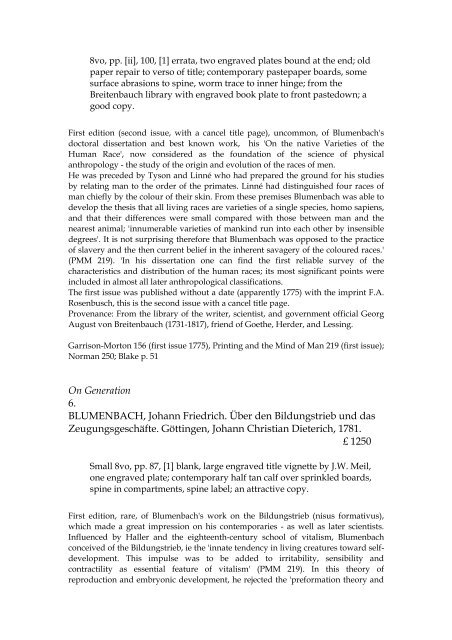«Merge Record #»«Title» - Schulz-Falster Rare Books
«Merge Record #»«Title» - Schulz-Falster Rare Books
«Merge Record #»«Title» - Schulz-Falster Rare Books
You also want an ePaper? Increase the reach of your titles
YUMPU automatically turns print PDFs into web optimized ePapers that Google loves.
8vo, pp. [ii], 100, [1] errata, two engraved plates bound at the end; old<br />
paper repair to verso of title; contemporary pastepaper boards, some<br />
surface abrasions to spine, worm trace to inner hinge; from the<br />
Breitenbauch library with engraved book plate to front pastedown; a<br />
good copy.<br />
First edition (second issue, with a cancel title page), uncommon, of Blumenbach's<br />
doctoral dissertation and best known work, his 'On the native Varieties of the<br />
Human Race', now considered as the foundation of the science of physical<br />
anthropology - the study of the origin and evolution of the races of men.<br />
He was preceded by Tyson and Linné who had prepared the ground for his studies<br />
by relating man to the order of the primates. Linné had distinguished four races of<br />
man chiefly by the colour of their skin. From these premises Blumenbach was able to<br />
develop the thesis that all living races are varieties of a single species, homo sapiens,<br />
and that their differences were small compared with those between man and the<br />
nearest animal; 'innumerable varieties of mankind run into each other by insensible<br />
degrees'. It is not surprising therefore that Blumenbach was opposed to the practice<br />
of slavery and the then current belief in the inherent savagery of the coloured races.'<br />
(PMM 219). 'In his dissertation one can find the first reliable survey of the<br />
characteristics and distribution of the human races; its most significant points were<br />
included in almost all later anthropological classifications.<br />
The first issue was published without a date (apparently 1775) with the imprint F.A.<br />
Rosenbusch, this is the second issue with a cancel title page.<br />
Provenance: From the library of the writer, scientist, and government official Georg<br />
August von Breitenbauch (1731-1817), friend of Goethe, Herder, and Lessing.<br />
Garrison-Morton 156 (first issue 1775), Printing and the Mind of Man 219 (first issue);<br />
Norman 250; Blake p. 51<br />
On Generation<br />
6.<br />
BLUMENBACH, Johann Friedrich. Über den Bildungstrieb und das<br />
Zeugungsgeschäfte. Göttingen, Johann Christian Dieterich, 1781.<br />
£ 1250<br />
Small 8vo, pp. 87, [1] blank, large engraved title vignette by J.W. Meil,<br />
one engraved plate; contemporary half tan calf over sprinkled boards,<br />
spine in compartments, spine label; an attractive copy.<br />
First edition, rare, of Blumenbach's work on the Bildungstrieb (nisus formativus),<br />
which made a great impression on his contemporaries - as well as later scientists.<br />
Influenced by Haller and the eighteenth-century school of vitalism, Blumenbach<br />
conceived of the Bildungstrieb, ie the 'innate tendency in living creatures toward selfdevelopment.<br />
This impulse was to be added to irritability, sensibility and<br />
contractility as essential feature of vitalism' (PMM 219). In this theory of<br />
reproduction and embryonic development, he rejected the 'preformation theory and
















